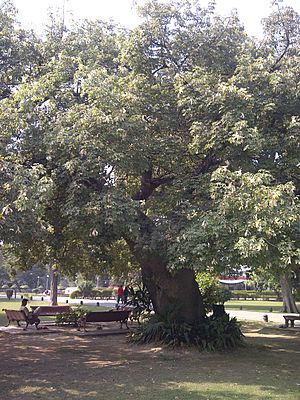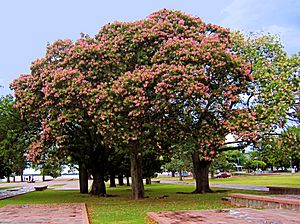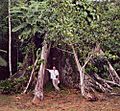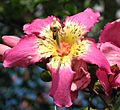Ceiba facts for kids
Quick facts for kids Ceiba |
|
|---|---|
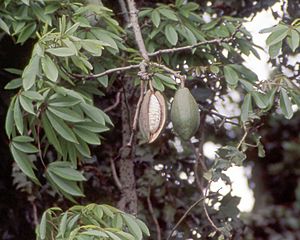 |
|
| Ceiba pentandra leaves and fruit | |
| Scientific classification |
|
| Kingdom: | Plantae |
| Clade: | Tracheophytes |
| Clade: | Angiosperms |
| Clade: | Eudicots |
| Clade: | Rosids |
| Order: | Malvales |
| Family: | Malvaceae |
| Subfamily: | Bombacoideae |
| Genus: | Ceiba Mill. |
| Species | |
|
18 species, see text |
|
Ceiba (say "SAY-bah") is a group of amazing trees. They belong to the Malvaceae family, which also includes cotton plants! These trees grow in warm, wet places. You can find them in tropical and subtropical parts of the Americas. This includes places like Mexico, the Caribbean, and down to northern Argentina. They also grow in tropical West Africa.
Some Ceiba trees are super tall. They can grow over 70 meters (about 230 feet) high! That's taller than many buildings. Their trunks are usually straight and don't have many branches until very high up. At the top, they have a huge, wide crown of leaves. Many Ceiba trees have special roots called buttress roots. These roots look like giant planks coming out of the trunk. They can be taller than a grown person!
The most famous type of Ceiba tree is the Kapok tree, or Ceiba pentandra. Its fluffy fibers are used for many things. Some butterfly and moth larvae (caterpillars) also like to eat Ceiba leaves. One tiny caterpillar, called Bucculatrix ceibae, only eats Ceiba leaves!
Contents
Ceiba Trees in History and Culture

Ceiba trees are very important in the history and beliefs of many cultures. Especially in ancient Mesoamerica, where the Maya civilization lived.
Ancient Beliefs
For the ancient Maya, the Ceiba tree was like a "world tree." They called it ya’axché. They believed it connected the sky, the Earth, and the underworld (which they called Xibalba). Imagine a giant tree whose roots go deep into the Earth and whose branches reach the heavens! This idea of a central world tree was often shown as a Ceiba trunk. The thick, pointy thorns on the trunk of the Ceiba tree were even copied by the Maya on their special pottery.
Even today, many modern Maya people still respect these trees. They often leave Ceiba trees standing when they are cutting down other trees in the forest. The Ceiba tree is also shown as a cross in the famous Temple of the Cross Complex at Palenque.
Famous Ceiba Trees
There are many famous Ceiba trees around the world!
- In Ponce, Puerto Rico, there's a place called Ceiba Tree Park. Its main attraction is the historic Ceiba de Ponce. This tree is over 500 years old! People believe it's linked to the founding of the city. Old pieces of pottery and shells found nearby show that Taino people lived there long before the Spanish arrived.
- In 1525, a Spanish leader named Hernán Cortés ordered the hanging of the Aztec emperor Cuauhtemoc from a Ceiba tree.
- The town of Chiapa de Corzo, Chiapas, Mexico, was founded in 1528. It was built around a Ceiba pentandra tree called La Pochota.
- The Puerto Rican town of Ceiba was founded in 1838 and is also named after this tree.
- The city of La Ceiba in Honduras was named in 1877 after a special Ceiba tree that grew near its old docks.
- In 1898, the Spanish Army gave up to the United States under a Ceiba tree in Santiago de Cuba. This tree is now known as the Santiago Surrender Tree.
The Ceiba is also the national tree of Guatemala. The most important Ceiba in Guatemala is called La Ceiba de Palín Escuintla. It is more than 400 years old! In Caracas, Venezuela, there is a 100-year-old Ceiba tree in front of the San Francisco Church. It's called La Ceiba de San Francisco and is an important part of the city's history.
What Are Ceiba Trees Used For?
The Ceiba pentandra tree produces a light and strong fiber. This fiber is called kapok. For a long time, kapok was used to fill mattresses, pillows, and even dolls! Today, people often use man-made fibers instead of kapok.
The seeds of the Ceiba tree can also be used. Oil is taken from the seeds to make soap and fertilizers. Ceiba products are still sold in Asia, especially in places like Java, Malaysia, Indonesia, and the Philippines.
A famous Nicaraguan poet named Pablo Antonio Cuadra wrote about the Ceiba tree. He saw it as a symbol of his country's old roots. He felt it was like a safe home for the nation.
Types of Ceiba Trees
There are about 20 different types, or species, of Ceiba trees. Here are some of them:
- Ceiba acuminata (found in Mexico and Honduras)
- Ceiba aesculifolia (found from Mexico to Costa Rica)
- Ceiba boliviana (found in southern Peru to Bolivia)
- Ceiba chodatii (found in southeastern Bolivia to Paraguay and northern Argentina)
- Ceiba crispiflora (found in southeastern Brazil)
- Ceiba erianthos (found in eastern Brazil)
- Ceiba glaziovii (found in northeastern Brazil)
- Ceiba insignis (found in southern Ecuador and northern Peru)
- Ceiba jasminodora (found in southeastern Brazil)
- Ceiba lupuna (found in northwestern Brazil and Peru)
- Ceiba pentandra (found in Mexico, Central America, the Caribbean, and northern South America)
- Ceiba pubiflora (found from northeastern Brazil to Argentina)
- Ceiba rubriflora (found in eastern Brazil)
- Ceiba salmonea (found in Peru)
- Ceiba samauma (found from Amazonia to Paraguay)
- Ceiba schottii (found in southeastern Mexico and Guatemala)
- Ceiba soluta (found in Guatemala)
- Ceiba speciosa (found from Amazonia to Paraguay)
- Ceiba trischistandra (found in western Ecuador and northwestern Peru)
- Ceiba ventricosa (found in eastern Brazil)
Images for kids
-
Ceiba pentandra found in the center plaza of Chiapa de Corzo, Chiapas, Mexico.
-
Ceiba speciosa in Lahore
-
Ceiba speciosa in Lahore
See also
 In Spanish: Ceiba para niños
In Spanish: Ceiba para niños


